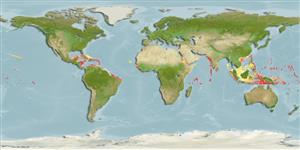Common names from other countries
>
Anguilliformes (Eels and morays) >
Muraenidae (Moray eels) > Uropterygiinae
Etymology: Channomuraena: Greek, chanos, -eos, ous, and chasma, -atos = abyss, mouth opened, inmensity + Latin, muraena = morey eel (Ref. 45335).
More on author: Richardson.
Environment: milieu / climate zone / depth range / distribution range
Ökologie
seewasser riff-verbunden; tiefenbereich 5 - 100 m (Ref. 5217), usually 7 - 37 m (Ref. 37816). Tropical; 24°N - 11°S
Circumtropical. Indian Ocean: Reunion and Mauritius (Ref. 33390) and Christmas Island. Western Pacific: Palau, and the Hawaiian Islands. Western Atlantic: Bermuda, Bahamas, and Caribbean Sea; may occur in southern Florida, USA and northwestern Gulf of Mexico (Ref. 7251). Reported from Bahia, Brazil (Ref. 57756). Eastern Atlantic: around oceanic islands.
Size / Gewicht / Alter
Maturity: Lm ? range ? - ? cm
Max length : 150 cm TL Männchen/unbestimmt; (Ref. 37816); common length : 80.0 cm TL Männchen/unbestimmt; (Ref. 5217)
Kurzbeschreibung
Morphologie | Morphometrie
Rückenflossenstacheln (insgesamt): 0; Rückenflossenweichstrahlen (insgesamt): 0; Afterflossenstacheln 0; Afterflossenweichstrahlen: 0. The small cranium, anterior position of the eyes, and enlarged lower jaw are unique (Ref 1602)
A benthic species and solitary species (Ref. 26340) inhabiting outer reef slopes. Occurs under ledges and in holes of reef slopes (Ref. 37816). Has the habit of puffing its head like a cobra when approached (Ref. 37816). Secretive and nocturnal (Ref. 48635). Minimum depth reported taken from Ref. 30874.
Life cycle and mating behavior
Geschlechtsreife | Fortpflanzung | Ablaichen | Eier | Fecundity | Larven
Böhlke, J.E., 1981. Muraenidae. In W. Fischer, G. Bianchi and W.B. Scott (eds.) FAO species identification sheets for fishery purposes. Eastern Central Atlantic, (Fishing Areas 34, 47 (in part)), Vol. 3. [var. pag.]. FAO, Rome. (Ref. 3254)
IUCN Rote Liste Status (Ref. 130435)
CITES (Ref. 128078)
Not Evaluated
Bedrohung für Menschen
Harmless
Nutzung durch Menschen
Fischereien: kleinfischerei; Aquarium: Kommerziell
Mehr Information
NamenSynonymeMetabolismusRäuberÖkotoxikologieFortpflanzungGeschlechtsreifeAblaichenFecundityEierEientwicklung
Alter/GrößeWachstumLänge-GewichtLänge-LängeLängenhäufigkeitenMorphometrieMorphologieLarvenLarven Pop.Dyn.RekrutierungDichte
ReferenzenAquakulturAquakultur ProfilZuchtlinienGenetikElectrophoresesVererbbarkeitKrankheitenVerarbeitungMass conversion
PartnerBilderStamps, Coins Misc.LauteCiguateraGeschwindigkeitSchwimmstilKiemenoberflächeOtolithsGehirngrößeSehfähigkeit
Tools
Zusatzinformationen
Download XML
Internet Quellen
Estimates based on models
Preferred temperature (Ref.
115969): 25.5 - 28.9, mean 27.7 (based on 388 cells).
Phylogenetic diversity index (Ref.
82804): PD
50 = 0.7500 [Uniqueness, from 0.5 = low to 2.0 = high].
Bayesian length-weight: a=0.00069 (0.00033 - 0.00144), b=3.12 (2.93 - 3.31), in cm Total Length, based on LWR estimates for this (Sub)family-body shape (Ref.
93245).
Trophic level (Ref.
69278): 4.0 ±0.66 se; based on food items.
Widerstandsfähigkeit (Ref.
120179): sehr niedrig, Verdopplung der Population dauert mehr als 14 Jahre. (Preliminary K or Fecundity.).
Fishing Vulnerability (Ref.
59153): Very high vulnerability (90 of 100).
